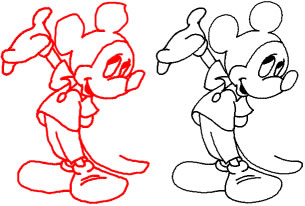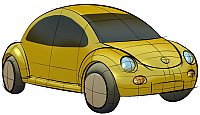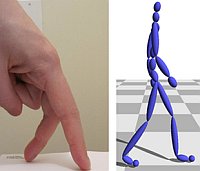CSC490 Winter 2014: Capstone Design course
This course gives students experience solving a substantial problem that may span several areas of Computer Science. Students will define the scope of the problem, develop a solution plan, produce a working implementation, and present their work using written, oral, and (if suitable) video reports. Class time will focus on the project, but may include some lectures. The class will be small and highly interactive.
Professor:
Karan Singh (http://www.dgp.toronto.edu/~karan)
Theme:
 |
 |
 |
 |
 |
| ...beautify rough drawings | ...understand gestures, objects | ...give them a 3D look | ...make them move | ...explore interactivity |
This capstone will focus on stroke, touch and mobile interaction for a variety of creative applications not limited to sketching, modeling, animation, audio and visualization.
While the widespread adoption of mobile devices has made stroke and touch interaction common-place, its potential for creative visual communication is still in infancy.
In this course, we will explore new prototypes for stroke touch and mobile interaction within University of Toronto’s graphics and human-computer interaction laboratory (www.dgp.toronto.edu). Students will have access to a variety of cutting edge input and output devices including 3D scanners, 3D printers, motion capture, pico projectors and numerous smartphones and tablets that will facilitate content creation using novel interaction techniques. Students will be given considerable freedom to define projects of their choice, with appropriate advice and assistance provided by the instructor and teaching assistants. Some projects may have graduate student involvement. In short this course is tailored to creative people with good technical skills and a flair for problem solving or research.
Grading scheme:
-Assignment: 5% + 5% bonus
- project sketch: 5% (due in third class)
- first prototype: 20% (due by mid-feb. 2014)
- implementation and demo of project: 40% (due by early april 2014)
- final presentation of the project: 20% (due by early april 2014)
- final report and webpage: 10% (due by early april 2014)
Duration:
The class will meet once a week R 3-5 (BA 5181) in the Dynamic Graphics Project lab (http://www.dgp.toronto.edu) or as specified the week before.
There are no exams in this course.
Prerequisites:
The biggest pre-requisite for this course is a creative mind and a can-do attitude.
Understanding of basic image processing and computer graphics concepts and programming (also for mobile devices) is desirable but not essential.
If you want to see the kind of stuff that students produce in this course check the film and film credits of the spine by Oscar winning director Chris Landreth (NFB Canada).
A number of tools were written to help model the characters and the rendering effects you see in the film.
Enrolment limit:
The course will be limited to 20 students.
Should demand exceed available spaces, preference will be given to students who have a graphics and HCI background.
Lectures and other Notes: